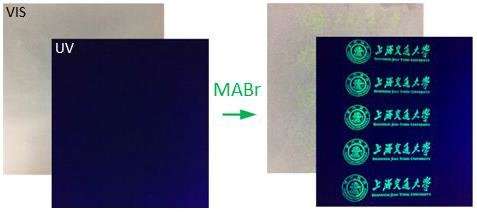November 1, 2017 report
Researchers report a new and better kind of invisible ink

(Phys.org)—A team of researchers from Shanghai Jiao Tong University and Jinan University, both in China, has developed a new type of invisible ink. In their paper published in the journal Nature Communications, the group describes how the ink is made and used, and what they are doing to make it safer.
People have been trying to write messages that only intended recipients can read for as long as there have been messages, but most methods leave a lot to be desired. In this new effort, the group in China is claiming to have developed an ink that overcomes problems with other methods, though at a price.
As the researchers note, they were trying to synthesize a type of glowing nanomaterial when they found they had created something else—a type of invisible ink that could be made visible on demand, and then made invisible again.
The ink works by converting a lead-based metal organic framework to luminescent perovskite nanocrystals. In practice, it is printed using an ordinary inkjet printer onto paper. A person looking at the paper would not be able to see what was written until they applied salt—doing so would cause a chemical reaction causing the information printed on the paper to become visible when exposed to UV light. After reading the message, the person could then apply salt again, causing another reaction, rendering the information invisible again.
The researchers suggest the ink could be used to protect confidential or private information on printed documents. They note that it could also prove useful with electronics, the original goal of the research. It allows for richer colors on a screen.
Unfortunately, there is one major problem with the ink—the lead it contains is toxic. A person reading the letter would likely come in contact with the ink, possibly experiencing lead poisoning. The researchers acknowledge this problem and report that they are working on a possible solution using tin instead of lead. There is also a question of how many times the ink can be used.
More information: Congyang Zhang et al. Conversion of invisible metal-organic frameworks to luminescent perovskite nanocrystals for confidential information encryption and decryption, Nature Communications (2017). DOI: 10.1038/s41467-017-01248-2
Abstract
Traditional smart fluorescent materials, which have been attracting increasing interest for security protection, are usually visible under either ambient or UV light, making them adverse to the potential application of confidential information protection. Herein, we report an approach to realize confidential information protection and storage based on the conversion of lead-based metal-organic frameworks (MOFs) to luminescent perovskite nanocrystals (NCs). Owing to the invisible and controlled printable characteristics of lead-based MOFs, confidential information can be recorded and encrypted by MOF patterns, which cannot be read through common decryption methods. Through our conversion strategy, highly luminescent perovskite NCs can be formed quickly and simply by using a halide salt trigger that reacts with the MOF, thus promoting effective information decryption. Finally, through polar solvents impregnation and halide salt conversion, the luminescence of the perovskite NCs can be quenched and recovered, leading to reversible on/off switching of the luminescence signal for multiple information encryption and decryption processes.
Journal information: Nature Communications
© 2017 Tech Xplore




















